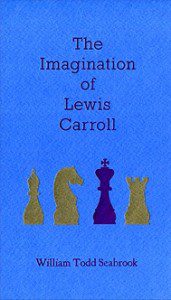
“’The time has come,’ the Walrus said, / ‘To talk of many things: / Of shoes—and ships—and sealing wax— / Of cabbages—and kings— / And why the sea is boiling hot— / And whether pigs have wings.’” So my pre-algebra teacher would begin when it came time to change our seating chart, to scramble his fifty-minute portion of our lives and throw our partner-work alliances into disarray. It was an appropriate deployment of Lewis Carroll: ridiculous but meaningful, wickedly playful and ritualistically attention-grabbing, and totally, completely nonsensical. William Todd Seabrook’s latest book, The Imagination of Lewis Carroll, handles the man, his mind, and his work in a similarly suitable manner.
Preceded by The Genius of J. Robert Oppenheimer and The Passion of Joan of Ark, the book is the latest in a series of flash biographical fiction chapbooks centering on the internal workings of the famous and slightly mythical. It’s more creative re-imagining than biography, more View-Master than critical study. It moves in lithesome, sprightly ways, progressing one image, one myth at a time. In one section you’ll find nine potential solutions to the riddle, “Why is a raven like a writing desk?” In another lies a scenic reconstruction of Alice in Wonderland‘s genesis during a boat ride on the Thames. In yet a third awaits the philosophical confrontation between a whimsically serious Carroll and a deadly serious priest. Any attempt to quote one sentence or paragraph in isolation from its natural surroundings leaves Seabrook’s prose almost entirely decharmed. Its power, humor, and spirit lie in the tight progression from slide to slide, in the cumulative effect of the whole set.

If you come to the book as I did, with relatively little knowledge of Carroll’s biography, you will leave the venture about as uncertain as when you began. You know that Carroll was a clever mathematician as well as a writer, but did he really invent 5,000 card games, “the majority of them versions of solitaire?” You know that the Red Queen in Alice cries “Off with his head!” often and with much gusto, but did Carroll really witness a beheading as a child and misinterpret it as a splendid entertainment? And you’ve heard that he reveled in a good long conversation with a girl child dandled on his knee, but did he really take photographs of a naked Alice? Seabrook provides no answers, only breaks off the chapters and moves swiftly on.
To be fair, Seabrook never purports to be writing a biography or hewing as close to the facts as possible. His chosen path is that of suggestion, such as when, in the first chapter, Carroll takes Lorina, Alice, and Edith out on the Thames and almost tips “the picnic basket into the water, […] scattering a family of ducks.” It’s a quiet sentence, but it contains the whole path of the book, from a Sunday-picnic world of childhood innocence and early authorship to a tipped-basket, scattered-duck world of opium, photography of nude children, and a complete withdrawal from the world; from a man coyly engaged in on-the-side riddle-making and storytelling to an “author twice removed from reality in all ways,” who, when faced with the presence of a grown-up Alice Liddell, comments that it’s “better to be dead than to be lonely.” Forget scattering the ducks. They have drowned themselves.
At just forty-three pages and evenly divided into two-page bursts, The Imagination of Lewis Carroll is a slim little curio cabinet of anecdotes, lists, and scenes, an advent calendar for a Carroll-themed holiday that never existed, but might. There are moments when some readers might want more answers, and moments (such as when Carroll cracks into shards after being struck by a priest) when others might want less whimsy, but it would be wrong to fault a book that takes so little of your time and gives such a quick jolt of sweetness in return.




